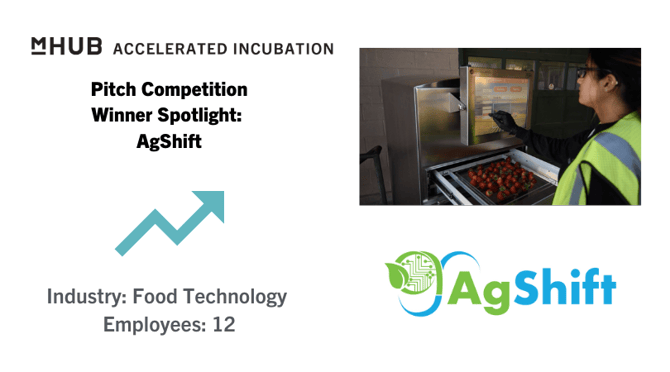AgShift is Solving Complex Challenges in Food Supply Chain

AgShift was the first place winner at the mHUB Industrial Startup Pitch Competition. You can find a recap of the event here.
Miku Jha, Founder & CEO of AgShift, recognized the lack of access to automation, data, insights in the food and Ag ecosystem after seeing the massive effects of the drought in both California and India in 2016. However, more surprising was the fact that there were very few entrepreneurs who wanted to change this equation. With that, Miku left her position at IBM and started AgShift to close the technology gap. Now, AgShift is solving complex challenges in food supply chain & playing a role in significantly reducing food waste. We sat down with Miku to learn more about the company, her personal entrepreneurial journey, her predictions for the future of IIoT in the Ag industry.
What inspired you to become an entrepreneur? What are some highlights from your journey?
As a technology entrepreneur and a product executive, I have successfully built many successful startups and led execution of large scale enterprise products at companies such as IBM, VMware. A lot of compelling and viable technical innovations in AI, Analytics and Big data doesn’t make it to food and Ag because young technology entrepreneurs are outsiders to this ecosystem and find it overwhelming to break the silos. To close this technology gap – was what motivated me to start AgShift.
The vision behind AgShift was rather deep rooted.
I am part of a small farm holder community in India and grew up understanding the difficulties of food and ag business from a grower perspective. In 2016, As a technologist, at IBM, I was leading internet-of-things initiative – where I was mentoring many startups on sensor, drone and data related technologies for large farms and Ag ecosystem.
The same year there was a massive drought in California and also back home in India. The lack of access to automation, data, insights in the food and Ag ecosystem was evident. However, more surprising was the fact that there were very few entrepreneurs who wanted to change this equation. Technology benefits from data, insights and automation of repetitive tasks, which was easily accessible and deployed in other verticals was not derived or realized by food and Ag ecosystem. It was a clear gap for something which is most crucial to all of us -food. The evolution of operational efficiencies in food ecosystem was possible with technology enabled automation. I was convinced that even a slight improvement in automation and data insights, could deliver massive benefits to the food supply chain. With this conviction, I left IBM and founded AgShift.
Today, Agshift is one of the most innovative AI companies – solving complex challenges in food supply chain and playing a role in significantly reducing food waste.
How the pandemic changed the current industry scenario? What are your future predictions about the industry?
In the current COVID-19 crisis, organizations are operating at 25% of their capacity – not having enough manual labor to do quality inspections. The bottle neck is not the demand or the supply but rather the manual dependency to inspect food which is attributing to food waste across the supply chain. Organizations also have to reduce the number of samples inspected to fulfill the need for food in the current crisis which is creating an immense pressure across the supply chain with suboptimal quality.
In the aftermath of current COVID-19 crisis – it has become imperative for our customers to invest in automation and digitization of quality assessment processes, to augment the current manual processes to mitigate the projected future impact of COVID-19 crisis. The crisis has created a sense of urgency across our customer base to invest in technology and automation to be better prepared for the future. It has shortened the adoption curve for our solutions.
The need to automate many of the manual, tedious and error-prone tasks – is now expedited for organizations in food supply chain. The key stake holders and decision makers are now actively looking to invest in automation technologies, to be better prepared for the future.
Tell us a bit more about the services/products your company is offering.
AgShift is the leading AI automation platform for food quality assessment - enabling better, faster and objective quality assessment at scale compared to current manual processes.
The key aspects of our overall offering are:
Unique business value
AgShift is world’s first “Quality-management-system-in-a-box” solution for industrial automation of quality assessment. The only turn-key solution for food supply chain organization – to dynamically configure the quality acceptance criteria as per the business metric. Organizations can improve the quality metrics, significantly increase the sample size and do better product mixes for higher margins.
Businesses can do better, faster and more objective quality assessment on increased samples with higher throughput and digitized audit trail.
Unique AI technology
Highly scalable, Proprietary Auto-ML framework:
• Requires low investment from AgShift to support a new commodity
• Requires low investment from customers to annotate their data. As they annotate more data, model keeps on improving with auto-feedback loop
• Solution can support all commodities for all types of visual defects
Unique data repository
AgShift’s problem statement is similar to clinical AI (Health care, medical imaging).
Food organizations do not have any existing repository for quality data. Food quality data is difficult to obtain. No other open-source data or standardization exists in the industry as it applies to food quality data.
AgShift is the only organization to have clean, curated, annotated data sets across several high value, high margin commodities.
Would you like to share any messages with our audience?
We are here to close the operational efficiency gap in the food supply chain and to reduce food waste. Our medium of choice happens to be technology. A message to all decision makers in the food supply chain – now is the time to invest in automation, invest in technology and to help young startups do what they do best – innovate and disrupt. Without the help of early adopters, investors and ecosystem technology entrepreneurs will always be cautious of taking that leap and stepping up to solving complex food challenges.
Keep your eyes on AgShift






